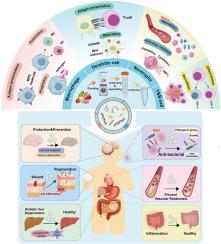植物源性囊泡样纳米颗粒免疫调节:机制和应用
IF 18
1区 医学
Q1 ENGINEERING, BIOMEDICAL
引用次数: 0
摘要
免疫失调会导致免疫系统的持续激活,导致全身性慢性炎症。这种情况明显破坏免疫稳态,并与许多慢性全身性疾病的发病密切相关。目前,免疫失调相关疾病的治疗面临着一些挑战,最明显的是长期使用免疫抑制药物的大量副作用和疗效不一致。因此,开发平衡功效和安全性的免疫调节策略已成为一个突出的研究重点。植物源性囊泡样纳米颗粒(PVLNs)是由植物细胞分泌的天然纳米材料,由于其优异的生物相容性、极小的免疫原性和跨物种的通讯能力,在免疫调节方面具有重要的潜力。本文综述了PVLNs的生物发生、组成和性质,重点介绍了它们介导的先天和适应性免疫调节机制及其在免疫失调疾病中的应用。它还分析了在其工程中遇到的与目标递送、稳定性优化、药物装载和存储相关的挑战。在未来,随着对PVLNs机制的深入了解和纳米技术的不断进步,它们在精确免疫治疗和临床转化方面的潜力有望进一步增强。本文章由计算机程序翻译,如有差异,请以英文原文为准。

Plant-derived vesicle-like nanoparticles for immunomodulation: Mechanisms and applications
Immune dysregulation can result in sustained activation of the immune system, leading to systemic chronic inflammation. This condition significantly disrupts immune homeostasis and is intimately associated with the onset of numerous chronic systemic diseases. Currently, the treatment of diseases related to immune dysregulation confronts several challenges, most notably the substantial side effects and inconsistent efficacy of long-term immunosuppressive drug use. Consequently, developing immunomodulatory strategies that balance efficacy and safety has emerged as a prominent research focus. Plant-derived vesicle-like nanoparticles (PVLNs), natural nanomaterials secreted by plant cells, exhibit significant potential in immunomodulation owing to their excellent biocompatibility, minimal immunogenicity, and cross-species communication capabilities. This paper reviews the biogenesis, composition, and properties of PVLNs, emphasizing the mechanisms of innate and adaptive immunomodulation they mediate and their applications in diseases characterized by immune disorders. It also analyzes the challenges related to target delivery, stability optimization, drug loading, and storage encountered in their engineering. In the future, as the mechanisms of PVLNs are more deeply understood and nanotechnology continues to advance, their potential in precision immunotherapy and clinical translation is anticipated to be further augmented.
求助全文
通过发布文献求助,成功后即可免费获取论文全文。
去求助
来源期刊

Bioactive Materials
Biochemistry, Genetics and Molecular Biology-Biotechnology
CiteScore
28.00
自引率
6.30%
发文量
436
审稿时长
20 days
期刊介绍:
Bioactive Materials is a peer-reviewed research publication that focuses on advancements in bioactive materials. The journal accepts research papers, reviews, and rapid communications in the field of next-generation biomaterials that interact with cells, tissues, and organs in various living organisms.
The primary goal of Bioactive Materials is to promote the science and engineering of biomaterials that exhibit adaptiveness to the biological environment. These materials are specifically designed to stimulate or direct appropriate cell and tissue responses or regulate interactions with microorganisms.
The journal covers a wide range of bioactive materials, including those that are engineered or designed in terms of their physical form (e.g. particulate, fiber), topology (e.g. porosity, surface roughness), or dimensions (ranging from macro to nano-scales). Contributions are sought from the following categories of bioactive materials:
Bioactive metals and alloys
Bioactive inorganics: ceramics, glasses, and carbon-based materials
Bioactive polymers and gels
Bioactive materials derived from natural sources
Bioactive composites
These materials find applications in human and veterinary medicine, such as implants, tissue engineering scaffolds, cell/drug/gene carriers, as well as imaging and sensing devices.
 求助内容:
求助内容: 应助结果提醒方式:
应助结果提醒方式:


